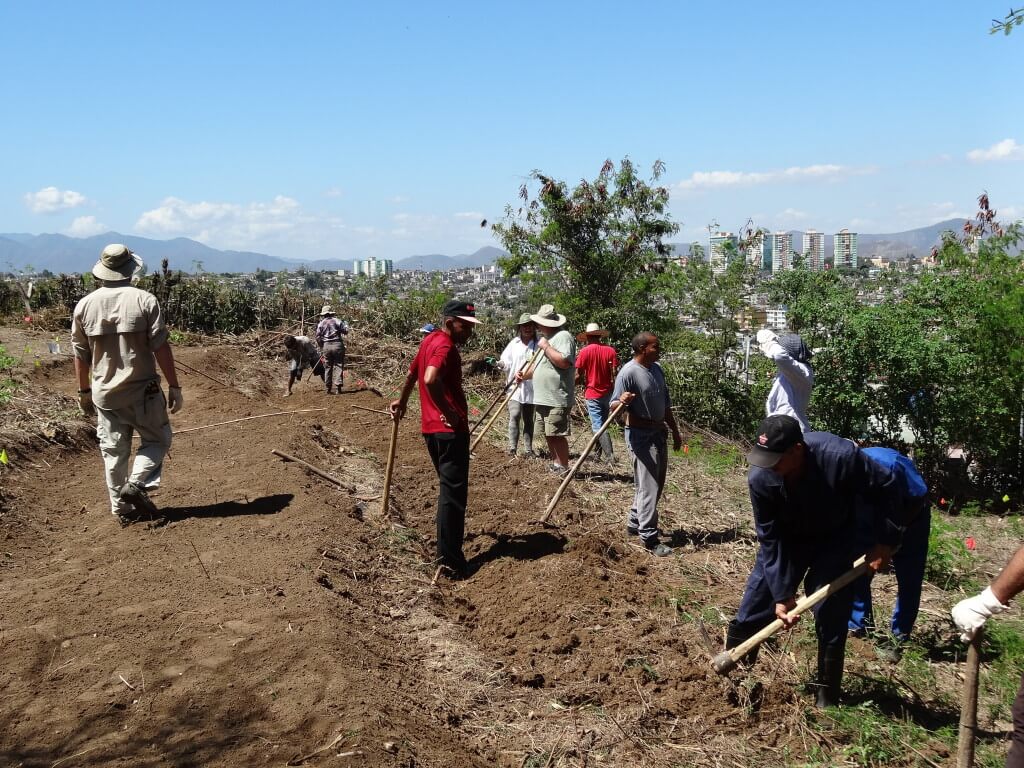El Pilar Farm Terraces and Water Management
Theft and hurricanes plague this semi-urban farm; the answer was a food de-fence.
Overview
On this 1.5 acre farm, a 2015 PDC class of 10 had just over a week to design and install a system to meet the needs of a family of five. The main points of the project design included increasing profitability of the farm, protection against theft and hurricanes, and incorporating the effluent from a biogas digester installed during the project.
In October of 2012, Hurricane Sandy had decimated the city and farm, making clear the need for protection from future storms. The final design created a storm-hardy agroforestry, keyline-inspired market garden, vermicomposting systems, terraces for doubling production of an existing pineapple crop, and a formidable living fence to deter would-be thieves.
All photos by Rick Ketcheson
Challenges
Defending the farm from theft was a key concern, as were hurricanes every 1-3 years, from June to November. They also needed to capture and store enough water to overcome the dry season. Students had a very short amount of time to learn, design and install the project, and were learning as they went. Resources in Cuba are scarce, and as a rule it is difficult or even impossible to find what you’re looking for - there’s lots of “make do to get done” required.
Key Elements
- 8 terraces, total ~120 m in length, planted with ~850 pineapple for juicing and delivery to local farm (100-200% increase over farm income)
- Lower portions of the property boundary planted with agave that grow up to 15 ft, with leaves fortified with barbed hooks
- Mulched terrace slopes vegetatively armoured against erosion
- Keyline-inspired market garden with in-situ compost and water harvesting hugelkultur
- Agroforestry integrated with moringa trees, cut in winter for maximum sunlight; summer foliage provides shade for annual crops
- Vermicomposting system under rabbit hutches to produce worms, a highly valued commodity in Cuba
- Designed system for stratifying effluent from biogas, allowing liquids to filter and fertigate fields below; solids put through additional vermicomposting system.
Update
The summer between 2015 and 2016 proved hot, and while there was some drought-related stress and plant die-off, the clients reported better water retention and growth from the market garden and terraces.
More projects
Berry and Fruit Terrace Orchard
Prolific berry and fruit production on terraces provides income and farm status.
Darfield Earthship Edible Landscape
An earthship gets a thriving edible landscape and shelter from cold winter winds.
Practical Permaculture Institute of Kenya
A permaculture training site in Kenya becomes a Garden of Eden and a hub of commerce.
Farm Scale Hugelkultur
A simple technique at farm scale helps a cooperative of farmers boost their productivity.
City Park Food Forest Retrofit
A retrofit design of a city-run dog park into a food forest orchard.
Rainwater and Irrigation Analysis
Analysis and earthworks to replace costly irrigation and road repair bills.













